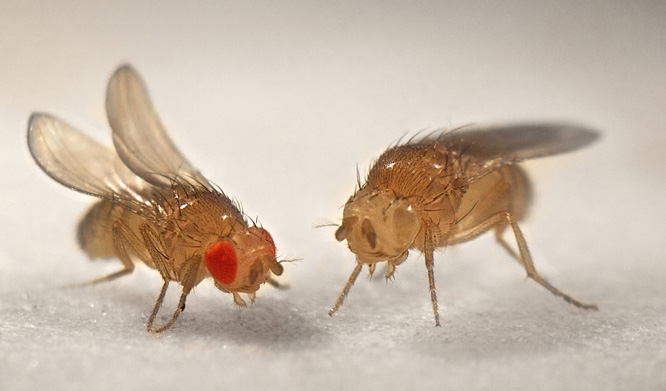Fruit flies that devote an excessive amount of time to grooming themselves could serve as a powerful tool for understanding the inherited disorder neurofibromatosis, type 1 (NF-1), report researchers in the latest issue of G3: Genes|Genomes|Genetics.

From King et al. See full video below.
NF-1 leads to the development of benign tumors in the peripheral nervous system. Common complications of NF-1 include a variety cognitive symptoms, such as learning disabilities, attention-deficit/hyperactivity disorder (ADHD), and features of autism spectrum disorder.
NF-1 is caused by mutations in the gene nf1, which encodes the cell growth regulator neurofibromin. Neurofibromin inhibits the ras signalling pathway, which is an evolutionarily conserved pathway that activates genes involved in many aspects of cell growth, differentiation and survival. Components of this pathway are often dysregulated in cancer.
The fruit fly Drosophila melanogaster also carries an nf1 gene. Despite the large evolutionary distance between humans and insects, nf1 mutant flies show learning and memory deficits, traits reminiscent of the human symptoms. This allows researchers to use the well-developed experimental toolkits of Drosophila to investigate the consequences of neurofibromin dysfunction.
King et al. investigated how neurofibromin affects Drosophila activity patterns across the day. They tracked movement in nf1 mutant and wildtype flies by measuring how often each fly crosses an infrared beam in the center of a glass tube. These experiments showed that nf1 mutants slept less, on average, than wild-type flies, and showed increased activity. But the “beam-crossing” data suggested there was more to the story than just greater movement of nf1 mutants. Most of the activity was concentrated in intense bursts, rather than an evenly distributed increase in all types of movement.
The authors hypothesized that these spikes of activity were due to self-grooming. Like most fly species, Drosophila invest considerable effort in keeping spick-and-span by brushing themselves with their legs, and cleaning their legs with their mouthparts. A fly that stops patrolling its environment to start grooming near the infrared beam is likely to cross its path many times — just as a cat will sit down to groom itself, fruit flies tend to stay put while they attend to their toilette.
The team tested this idea by observing videos of the beam-crossing experiments. They found that bursts of lots of beam-crossing in a short amount of time were usually caused by grooming, whether it was in wild-type or mutant flies, but nf1 flies showed more of these bursts. Flies with other mutations known to cause more general increases in activity did not show any difference in the number of these high-frequency spikes.
Detailed video analysis revealed that both wild-type and nf1 mutants groom frequently when they first encounter an unfamiliar space, but after 15 minutes getting used to their surroundings, the nf1 flies spend seven times more time self-grooming— the most extreme grooming phenotype yet reported.
This result is significant because the increased grooming phenotype is both specific (not caused by general increases in activity) and a trait amenable to high-throughput screening. This will allow researchers to screen for factors that affect neurofibromin function, to better understand the complex signaling cascade changes that occur in neurofibromatosis, and ultimately to identify sorely-needed strategies for treating one of the most common inherited disorders.
King, L. B., Koch, M., Murphy, K. R., Velazquez, Y., William, W. J., & Tomchik, S. M. (2016). Neurofibromin Loss of Function Drives Excessive Grooming in Drosophila.
G3: Genes| Genomes| Genetics, 6(4), 1083-1093. DOI: 10.1534/g3.115.026484 http://www.g3journal.org/content/6/4/1083.full













